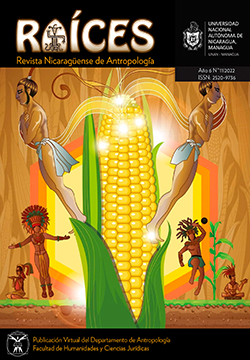The warrior dance in the festival of the sun: The case of cotacachi-Ecuador
DOI:
https://doi.org/10.5377/raices.v6i11.14507Keywords:
warrior dance, ringleader, festival of the sun, armay tuta, CotacachiAbstract
This article is a summary of the research: The role of the leaders or rukukuna in the festival of the Sun of the Kichwa people of Cotacachi, as an element of identity and cultural reaffirmation, was authorized and certified by the Board of Directors of the Center for Scientific Research and Technological (CUICYT) of the Technical University of the North (UTN); For this reason, this research is distinguished from the rituals performed during the warrior dance in the town square of Cotacachi. There, the Kichwa dancers who represent two opposing geographical sectors physically confronted each other until they hurt each other. The project examines the symbolic role of the ringleader who is the most accredited figure of the Sun festival. Due to its structure, the research is ethnographic in nature, which studies the festive process of the dancers. In this process, 48 indigenous leaders from 12 Kichwa communities were involved, who are primary source informants for this exploration, who at some point in their lives played the leading role of “leader or prioste” of the festival of the Sun. Among the The most relevant results show the leader and his companions as the most outstanding actors of the war dance; they recreate power and collective authority through rituals to win the square. It is concluded that the leaders, the more trajectory and social experience they have, the higher hierarchy they have in the ritual or habitual scenario; during the war dance they cause bloodshed and even the death of their opponents.
Downloads
679
References
Posso, M. (2013). Proyectos, Tesis, Marco Lógico. Quito, Imbabura, Ecuador: Noción Imprenta.
Rostoworowski, M. (1988). Estructuras andinas del poder. Lima: Instituto de Estudios Peruanos.
Turner, V. (1968). Proceso ritual: Estructura, Antiestructura. Versión castellana de la editorial Taurus. Rochester, New York, USA: Universidad de Rochester .
Zambrano, L. (12 de marzo de 2018). Licenciada en Linguistica. (N. Benitez, R. Cevallos, M. A. Posso, & M. Naranjo, Entrevistadores)
Zuidema, T. (1978). Mito, rito, calendario y geografía en el antiguo Perú (Vol. IV). París, Francia: Actes du XLII e Congres International des Americanistes.
Downloads
Published
How to Cite
Issue
Section
License
Copyright (c) 2022 © Universidad Nacional Autónoma de Nicaragua, Managua, UNAN-Managua

This work is licensed under a Creative Commons Attribution-NonCommercial-ShareAlike 4.0 International License.
This license enables reusers to distribute, remix, adapt, and build upon the material in any medium or format for noncommercial purposes only, and only so long as attribution is given to the creator. If you remix, adapt, or build upon the material, you must license the modified material under identical terms.




